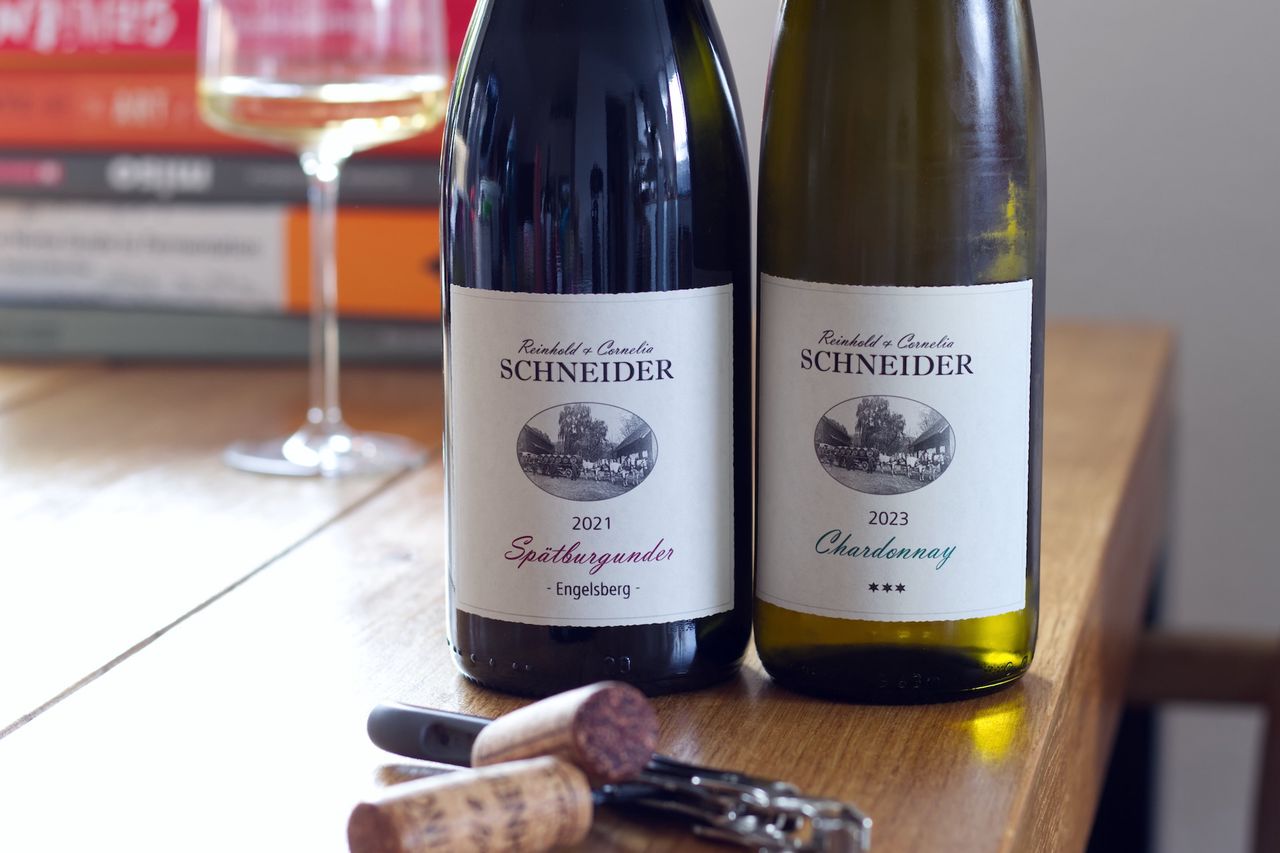Two Bottles Reinhold & Cornelia Schneider
From the Kaiserstuhl, we are drinking a bottle of Spätburgunder Engelsberg 2021 and a Chardonnay *** from 2023 by Reinhold and Cornelia Schneider.

When it comes to wine from the Kaiserstuhl, the name Reinhold and Cornelia Schneider comes up again and again. Their winery is located in Endingen, right in the Kaiserstuhl. Like so many winegrowers in Baden, the Schneiders have a background in the cooperative. In 1981, after leaving the cooperative, they founded their own winery. A few years later, they joined the VDP Baden. This is a fairly typical origin story for a good winery in this state, one might think, but if you look for the “Traubenadler”, the grape eagle, on their bottle necks, you’ll search in vain, just as they left the cooperative, the Schneider family has also left the VDP. A few years ago, their son Alexander joined the winery, the next generation, who in 2024 took over. Just under seven hectares of vineyards are cultivated: close to nature, with a lot of time and manual labor, and in a size where the reins can still be firmly held. In the cellar, too, there is time: slow pressing, spontaneous fermentation, and long aging on the lees. In many ways, it’s a bit like the old days here, the Grauburgunder is labeled “Ruländer”, the labels are very classic and simple, the top wines bear three stars on the bottle, a letter for the soil type or the vineyard name, and even the website feels a bit like it’s from another era. The Chardonnay, marked with three stars, is spontaneously fermented after pressing, undergoes malolactic fermentation, and is then matured in large, used wooden barrels. The wine from the Engelsberg is also spontaneously fermented, here on the skins, and then aged in large oak.
The Chardonnay smells of a mix of yellow stone fruit and very ripe pears, with herbs and some woody spice. I really like this kind of fruit, and I’m quite happy it comes through on the palate as well. Behind that come acidity, structure, and a bit of creaminess. That makes for a, watch out, trigger word, very delicious combination. I will never understand why “delicious” so often serves as an insult rather than a compliment. As if being delicious were somehow a bad thing. Whatever. On the palate, there’s more pome fruit than stone fruit, but not as ripe as on the nose. Pear, mirabelle, and apricot, a bit of stone, crisp and fresh. That’s really good.
The aroma becomes leaner overnight, although not much else changes. At least when drinking, it now has a much more lactic quality, somehow it reminds me of pear with yogurt, or ice cream, or frozen yogurt from one of those overpriced hipster street food stands. A bit of buttermilk, a few herbs. Incredibly fresh, definitely, with depth and drive. Semi-frozen with foam, yellow fruit, now incredibly long on the finish. Not exactly the development I expected after the intense yellow fruit the first evening, but somehow even a bit better than before. Still delicious, by the way, delicious in a different way, but actually almost more delicious than ever. And since the wine is priced at just €15, you can try it out without any risk.
Right after popping the cork on the Spätburgunder, there’s an enormous amount of cherry on the nose. But that already calms down after one or two hours in an open bottle. Wood and structure come forward, and if you inhale deeply, eucalyptus appears. On the first evening, it seems much cooler than the Chardonnay, sleeker, more linear. But 2021 was a cooler year, even in the sun-blessed Kaiserstuhl. The acidity definitely grabs hold, while the tannins are almost velvety. Still, it pulls at the tongue and palate. Plums, a bit of dried fruit, dry herbs, and some freshly cut wood. Really good. The Swabian in me unavoidably has to point out that this is clearly priced under €30. So, straight into the bargain category, and for me, at least, that puts an even bigger grin on my face. The eucalyptus from the nose also shows up on the middle of the tongue towards the end of the evening.
Things change in the fridge overnight. The fruit grows darker, the ethereal notes disappear, the spice becomes more intense and the herbs too. Now there’s black tea, both in the nose and mouth, and the acidity is reminiscent of fruit tea with rosehip or hibiscus, or whatever the tea maker mixes in there. I find that the wine has become fuller, not fatter, but more. It reaches further out to the edges of the tongue, takes over the cheeks a bit more, and is denser, more intense. At the same time, the acidity seems softer, less gripping. Now it feels more rested, more balanced, as if it could easily spend many more years in the bottle ahead. I have to say, the temptation to buy more is definitely there. Because I’m really interested in how it will age. Apparently, you can also get small quantities of matured wines directly from the winery, but then I, at least, wouldn’t know how they tasted young. With time in the bottle, unfortunately, there is no shortcut.